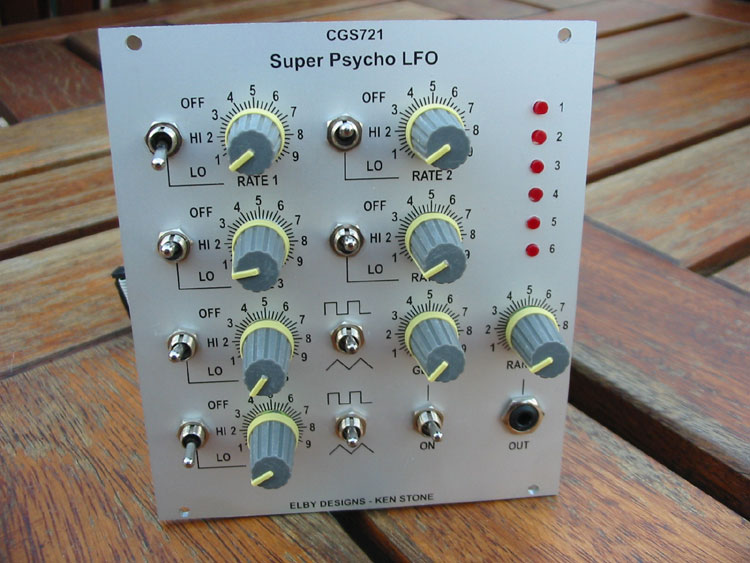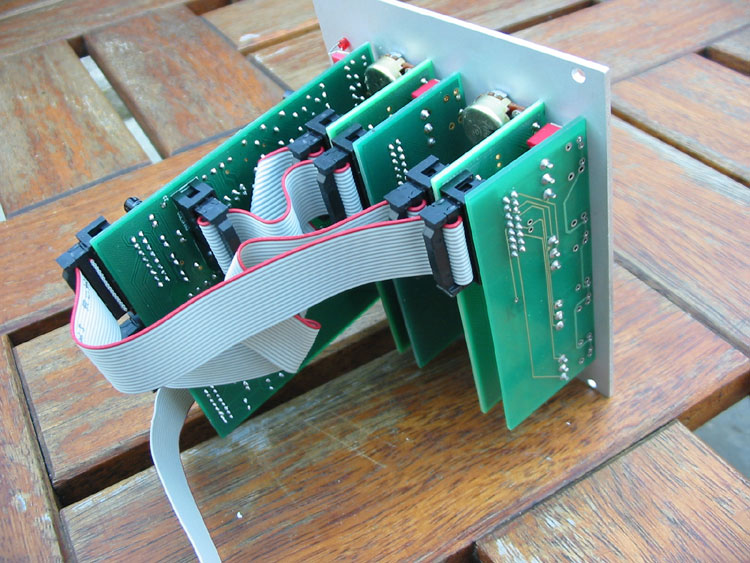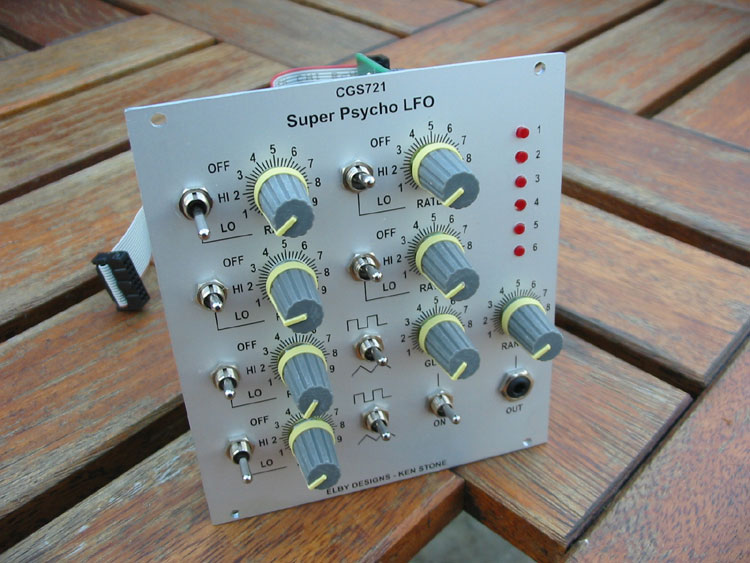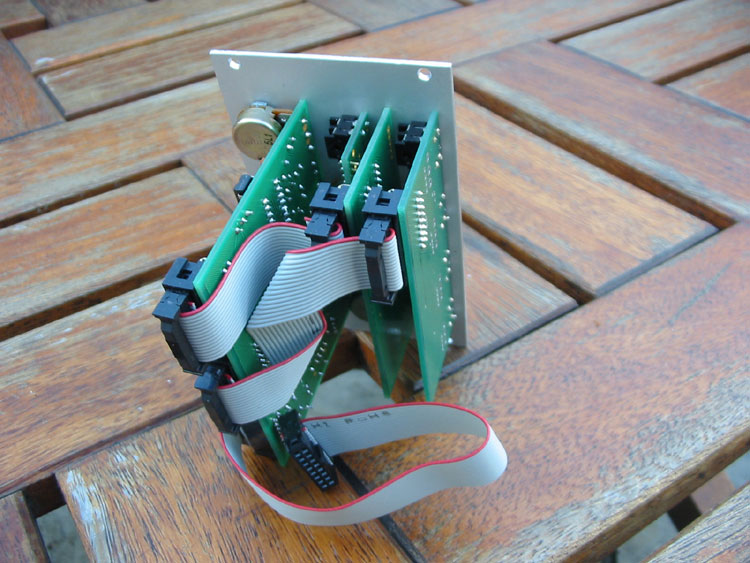Designed by Ken Stone, and bought to market by Laurie Biddulph of Elby Designs, TheBeast is proud to present The Panther Modular.
The module range is intended to work within the current market framework, set out by doepfer, analogue systems, et.al, but, insted of simply offereing yet another ‘moog ladder’ filter, to offer some truely unique modules, be it in function (Ken’s ‘Super Psycho LFO’ is a fortcomming module) or in sound (try recreating the Steiner filter eleswhere!)
These modules, of course, are fully compatible with the Eurorack systems offered by Doepfer, Plan-B, Analogue Solutions, and the like, and electronically compatible with Analogue Systems modules, although different power cables must be used.
This module is a much expanded version of the Psycho LFO, featuring six free-running oscillators, each variable between LFO and audio ranges, two of which can be switched to have triangular wave outputs. Each oscillator can be switched between low and high ranges, as well as off, and also has a rate LED, to allow visual determination of the frequency at which it is running. As per the original, there are also level and glide controls.
How to use this module
This module can be used to create a range of pseudo-random modulation voltages that can be used to generate unusual sequences, control VCFs or or VCAs etc. When run at higher frequencies, it can be used as a series of audio drones, or to generate complex sounds by frequency modulation a VCO.
A little on how it works
The Super Psycho Modulation Source is a fairly simple circuit with a lot of repetition. The circuit consists of several distinct blocks. The first are the oscillators, each based on a section of a 40106 hex schmitt inverter and their associated components. The switch allows extra capacitance to be added, reducing the speed of the oscillator to a lower range. The same switch allows the capacitor to be bypassed to the negative rail via a protection resistor, disabling the oscillator, and setting its output to near 0 volts. The 1M RATE pots allow the upper frequency range to extend over a large portion of the audio spectrum, and in the lower frequency position, to extend from sub-audio to low audio frequencies.
Two of the oscillators are equipped with voltage followers that follow the the, roughly, triangular shape of the wave present on the oscillator capacitors. The 100k and 360k resistors on the output, when coupled to the virtual ground summing node of the following mixer, via the switch, correct the amplitude and offset of the triangle wave.
The next block is a traditional op amp inverting mixer stage. Signals from the six oscillators are mixed through 470k resistors, the overall gain controlled by a 100k pot in the feedback path of the op amp.
What is interesting here is that in order to keep the output signal of the mixer positive without the need for an additional inverting stage, the chip used to build the six oscillators is powered from the negative rail, it’s positive power pin connected to 0V and its earth pin connected to -15V. Take special note of this, because it is an unusual way to power a digital chip, and inadvertent poking with a logic probe powered from the positive rail could cause you grief!
The final stage is a simple glide circuit consisting of a potentiometer, a capacitor and unity gain voltage follower. The switch is to allow easy switching in and out of a pre-adjusted glide setting.
Temporarily out of stock – GBP £na
(including EU taxes, excluding delivery)
This module is a “tribute” module, based on the awesome Steiner-Parker Synthacon VCF
How to use this module
Connect the CV input to a voltage source such as a keyboard, envelope generator or sequencer. Connect the output to a VCA or amplifier. Feed the signal to be filtered into the high-pass, band-pass or low-pass input. If the same signal is used in all inputs, the result is reminiscent of a phaser. The real fun starts when you feed different signals into each input, then you get a frequency based “interpolating scanner”, where panning between different sound sources is possible, though also subject to the frequency at which they are running.
Each of the filter type inputs has its own level control. The ALL input is also affected by these level pots as it mixed with the individual inputs prior to the level controls. If using only a single input, it may be better to feed the signal into the ALL input, and adjust the level pots to select LP, BP or HP, rather than changing the patch cord between the specific input jacks.
A little on how it works
The circuit uses a standard, non-inverting amplifier configuration. The three modes (HL, BP, LP) are obtained by injecting the signal into three different points of the circuit. An increase in the gain of the amplifier increases the filter’s Q. The Q remains almost constant as the filter is swept across the audio spectrum. In the circuit, diode strings are used as voltage controlled resistors.
The differential-amplifier transistors apply the bias voltage to the parallel diode string RC networks in opposing phase. The opposing phases cancel the control voltage so that none appears at the output. The final pair of transistors form a non-inverting amplifier. The variable resistor adjusts the gain of this amplifier, and thus its Q.
The final stage is a simple gain stage.
Temporarily out of stock – GBP £na
(including EU taxes, excluding delivery)
This module is a dual utility LFO offering manually variable wave shapes. Standard waveshapes are falling ramp variable through triangle to rising ramp, and variable pulse width. A fixed square wave is also available, as is a combination waveshape that is variable between the TRI/SAW output and the SQUARE. This is a MIX not a morph. Two switches allow the variable outputs of the two LFOs to be intermixed.
How it works
The Utility LFO is based on the standard integrator/schmitt trigger oscillator core. Two pots in the integrator charge path allow for the adjustment of speed, and along with two diodes, for the adjustment of charge versus discharge time. Changing this ratio will allow the TRI/SAW output to be adjusted from a falling ramp through triangle to a rising ramp. At the same time, the output of the schmitt trigger will reflect this in the length of its output pulse.
A 0-volt referenced comparator connected to the output of the integrator generates a square wave as there is always an equal portion the ramp/triangle wave above the 0-volt reference, though adjustment of the shape of the ramp/triangle wave does change the phase of this square wave.
Following the comparator is a buffered voltage divider to bring the square wave down to a more suitable level and also to drive one side of the variable output mixer pot. The other side of the variable output mixer pot is connected directly to the integrator output. The variable output is buffered and used post mixer by another op-amp.
The JOIN switch interconnects the two VARI outputs by swapping their ramp outputs with each other, so that each output is a combination of that LFO’s square wave with the other’s ramp.
The SWAP switch reverses the outputs of the second LFO so that (when JOIN is on) one VARI output is a combination for both square waves while the other is a combination of both ramps. When JOIN is off, SWAP merely reverses the direction in which the second LFO’s VARI knob works.
Temporarily out of stock – GBP £na
(including EU taxes, excluding delivery)
This re-released version of the MIDI-2-SDS retains the same features as the original Version 2 model.
- It converts MIDI signals into SDS triggers, you can use it to fire other drum machines
- The unit has 8 trigger outputs, each of which is velocity sensitive
- Control of the ‘gate’ time is via an onboard preset (~1mS to ~132mS),
- It has a ‘learn’ mode, which lets you assign different notes to different triggers
- It has 8 LEDs, so you can see which channel is being triggered and which channel you are ‘teaching’.
It includes the following additional features:
- Adjustable upper and lower trigger output voltages. Upper voltage adjustable from 5V to 10V
- Dipswitch option to invert all trigger pulses (positive-to-negative, typically +5V to 0V)
Temporarily out of stock – GBP £na
(including EU taxes, excluding delivery)















